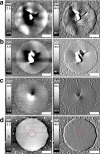Unveiling the Fatigue Behavior of 2D Hybrid Organic-Inorganic Perovskites: Insights for Long-Term Durability
- PMID: 37414727
- PMCID: PMC10502673
- DOI: 10.1002/advs.202303133
Unveiling the Fatigue Behavior of 2D Hybrid Organic-Inorganic Perovskites: Insights for Long-Term Durability
Abstract
2D hybrid organic-inorganic perovskites (HOIPs) are commonly found under subcritical cyclic stresses and suffer from fatigue issues during device operation. However, their fatigue properties remain unknown. Here, the fatigue behavior of (C4 H9 -NH3 )2 (CH3 NH3 )2 Pb3 I10 , the archetype 2D HOIP, is systematically investigated by atomic force microscopy (AFM). It is found that 2D HOIPs are much more fatigue resilient than polymers and can survive over 1 billion cycles. 2D HOIPs tend to exhibit brittle failure at high mean stress levels, but behave as ductile materials at low mean stress levels. These results suggest the presence of a plastic deformation mechanism in these ionic 2D HOIPs at low mean stress levels, which may contribute to the long fatigue lifetime, but is inhibited at higher mean stresses. The stiffness and strength of 2D HOIPs are gradually weakened under subcritical loading, potentially as a result of stress-induced defect nucleation and accumulation. The cyclic loading component can further accelerate this process. The fatigue lifetime of 2D HOIPs can be extended by reducing the mean stress, stress amplitude, or increasing the thickness. These results can provide indispensable insights into designing and engineering 2D HOIPs and other hybrid organic-inorganic materials for long-term mechanical durability.
Keywords: 2D hybrid organic-inorganic perovskites; failure behaviors; fatigue; in-plane; static dwelling.
© 2023 The Authors. Advanced Science published by Wiley-VCH GmbH.
Conflict of interest statement
The authors declare no conflict of interest.
Figures





Similar articles
-
In-Plane Mechanical Properties of Two-Dimensional Hybrid Organic-Inorganic Perovskite Nanosheets: Structure-Property Relationships.ACS Appl Mater Interfaces. 2021 Jul 14;13(27):31642-31649. doi: 10.1021/acsami.1c06140. Epub 2021 Jun 30. ACS Appl Mater Interfaces. 2021. PMID: 34189905
-
Exploring the Factors Affecting the Mechanical Properties of 2D Hybrid Organic-Inorganic Perovskites.ACS Appl Mater Interfaces. 2020 May 6;12(18):20440-20447. doi: 10.1021/acsami.0c02313. Epub 2020 Apr 22. ACS Appl Mater Interfaces. 2020. PMID: 32275132
-
Abnormal In-Plane Thermomechanical Behavior of Two-Dimensional Hybrid Organic-Inorganic Perovskites.ACS Appl Mater Interfaces. 2023 Feb 15;15(6):7919-7927. doi: 10.1021/acsami.2c17783. Epub 2023 Feb 5. ACS Appl Mater Interfaces. 2023. PMID: 36740778
-
Shedding light on the energy applications of emerging 2D hybrid organic-inorganic halide perovskites.iScience. 2022 Jan 7;25(2):103753. doi: 10.1016/j.isci.2022.103753. eCollection 2022 Feb 18. iScience. 2022. PMID: 35128355 Free PMC article. Review.
-
Spin Lifetime in Hybrid Organic-Inorganic Perovskites: Mechanisms, Measurements, and Prospects for Spintronic Applications.J Phys Chem Lett. 2025 May 22;16(20):5109-5120. doi: 10.1021/acs.jpclett.5c00644. Epub 2025 May 14. J Phys Chem Lett. 2025. PMID: 40367297 Review.
References
-
- Stoumpos C. C., Kanatzidis M. G., Perovskites H., Adv. Mater. 2016, 28, 5778. - PubMed
-
- Blancon J.‐C., Even J., Stoumpos C. C., Kanatzidis M. G., Mohite A. D., Nat. Nanotechnol. 2020, 15, 969. - PubMed
-
- National Renewable Energy Laboratory Best Research‐Cell Efficiency Chart 2023.
-
- Yoo J. J., Seo G., Chua M. R., Park T. G., Lu Y., Rotermund F., Kim Y.‐K., Moon C. S., Jeon N. J., Correa‐Baena J.‐P., Bulović V., Shin S. S., Bawendi M. G., Seo J., Nature 2021, 590, 587. - PubMed
-
- Yuan M., Quan L. N., Comin R., Walters G., Sabatini R., Voznyy O., Hoogland S., Zhao Y., Beauregard E. M., Kanjanaboos P., Lu Z., Kim D. H., Sargent E. H., Nat. Nanotechnol. 2016, 11, 872. - PubMed
Grants and funding
- Texas A&M Engineering Experiment Station
- Haythornthwaite Research Initiation American Society of Mechanical Engineer - Applied Mechanics Division and the Haythornthwaite Foundation
- DE-SC-0012541/U. S. Department of Energy, Office of Science, Basic Energy Sciences
- USF
- CMMI-2311573/National Science Foundation
LinkOut - more resources
Full Text Sources
Miscellaneous
